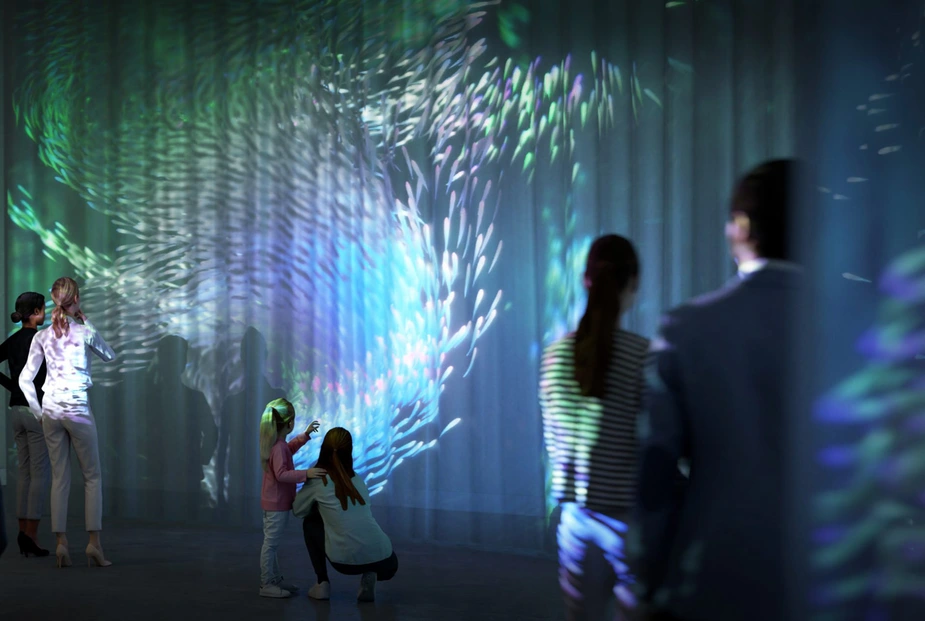An era of side effects
The Humboldt Laboratory will open on 7 January 2021 at Humboldt Forum. It will also feature research from Adlershof
A thinking space, a collaborative research project, and a place where science and the public enter into a dialogue: the Humboldt Laboratory in Berlin-Mitte will open its gates on 7 January 2021. The inaugural exhibition “After Nature” is the result of distilling an exchange of ideas between researchers of Berlin’s excellence cluster, the Integrative Research Institute on Transformations of Human-Environment Systems (IRI THESys), and the team of curator Gorch Pieken, which lasted a good two years. The exhibition’s focus: changes in climate, complex interactions of humans and nature, and the role of science in the 21st century.
Visitors of the Humboldt Laboratory’s lobby can look behind the curtain and dive into the depths and currents of scientific discourse. Six metres high and twelve metres wide, a virtual school of fish swims across the panels of fabric that guide the way into the heart of the exhibition. The fish visually react to any active interference by the visitors. “Depending on how the visitors behave, they can have a soothing effect on the fish, or agitate them, even make them panic,” says Gorch Pieken. “This is simple image that tells us: whatever we do has consequences for the world around us. And, with that, we almost unnoticeably slide into the world of science.”
Behind the curtain, the faces of Berlin’s science community are shown on screens. Ranging from swarm intelligence to controlling swarms of people using smart subway schedules, researchers from seven Berlin-based excellence clusters showcase their work. A short walk further at Humboldt Laboratory’s main room, Berlin’s scientific community presents itself interactively and digitally: Roll-ups sliding down from the ceiling act as screens for presentations by the researchers from the cluster “Contestations of the Liberal Script” (SCRIPTS) and IRI THESys, including four from Adlershof, to take a stand on contemporary issues. It is about changing climates in more ways than one – those caused by the destruction of the environment, and those directly caused by racism, chauvinism, and authoritarianism.
“The 21st century is an era of side effects,” says Pieken, citing a quote by philosopher Peter Sloterdijk, which is vividly depicted by the contribution of geographer Philippe Rufin. According to the post-doc researcher, about two thirds of all rivers worldwide were now constricted by dams, aimed to facilitate irrigation of farmland or the generation of hydroelectric energy. In tropical regions, the decomposition of flooded forests can release large quantities of greenhouse gases, cancelling out any positive emissions balance. Large dams were also used as instruments of geopolitical power to secure control of water resources. “These large-scale projects trigger issues of sustainability and distribution.”
Another sequence has professor of geography Patrick Hostert and post-doc Marcel Schwieder introduce modern remote sensing methods. “Satellite data are now extensively available with an unprecedented temporal and spatial resolution,” says Schwieder. “They enable us to document changes in vegetation and cultivation structures and, based on this, investigate questions pertaining to biodiversity in agrarian landscapes.” The emerging trends necessarily sparked controversial discussions. According to Schwieder, issues of world population growth, food security, and the liberal order of Western societies cannot be treated as separate issues.
Using other examples such as Professor Jonas Nielsen's telecoupling project, which shows the global ramifications of local political decisions, the exhibition pieces together data, flows of goods and information to create a mosaic of our time. The result is a portrait of a world that is so connected, it defies simple answers. “This is what we want to draw attention to, and also create an awareness for complexity and ambivalence, while democratising knowledge,” says Gorch Pieken, “and to make the expected three million annual visitors of our exhibition a part of scientific discourse.” An interactive wall will enable them to contact researchers and comment on subjects such as mobility, sustainability, and non-consumption. “It is likely that this will create new forms of knowledge that will also reflect back to universities.”
By Nora Lessing for Adlershof Journal
